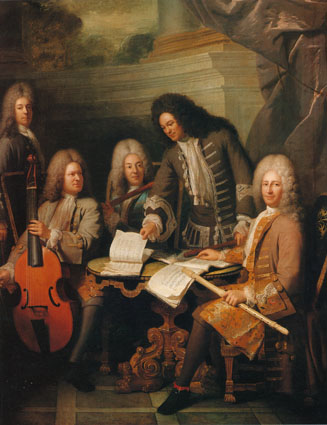

 |
 |
 INSTRUMENTAL MUSIC INSTRUMENTAL MUSIC |
| THE ORCHESTRA With the emergence of the opera, in the
early 17th century, music was increasingly written for groups of
players in combination, which is the origin of orchestral playing.
Also it was a develop in instruments construction. Bowed string family reached its maximum degree of perfection at the hands of luthiers like Stradivarius and Amati. Woodwinds were transformed in the French court of Versailles, appearing then the oboe, bassoon and baroque flute. SOLISTICS FORMS Preludes, Fantasies and Toccatas are pieces for solo instrument (usually keyboard) with improvisatory character, full of ornamentation.  These pieces were usually followed by a Fugue (a 2, 3, 4 or 5 voices): derived from the old ricercare. It has a brief melody called subject (theme)  introduce in voice and developed later in imitative counterpoint. introduce in voice and developed later in imitative counterpoint.SONATA The word "sonata" means a composition to be " sounded " , that is, for one or two instruments plus the usual basso continuo.  The most common combination included violin, flute or oboe for upper voices, and cello and chord instrument ( organ, harpsichord , harp , lute ...) for the continuo: its texture shows the typical voice polarization in the Baroque. Sonata used to be divided into three or four movements of character and tempo contrasting: Largo - Allegro - Adagio - Allegro. CONCERTO - CONCERTO GROSSO: It is a form of baroque music in which the musical material is passed between a small group of soloists (the concertino) and full orchestra (the ripieno or tutti). - SOLO CONCERTO: It is a concerto in which a single soloist is accompanied by an orchestra. It is the most frequent type of concerto nowdays. SUITE A suite is a serie of movements or dance pieces. Its classical sequence included : - Allemande : Quaternary German dance.  - Courante : Ternary and faster than the Allemande. - Sarabande : slow triple meter dance that accentuates typically the second pulse, Spanish origin . - Gigue : quick dance in various stages of ternary subdivision, Irish origin. In a suite we can find too: - Minuet : with the triple meter of the waltz . - Rondo : small piece based on the repetition of a theme ( A) , with intrusions ( B , C , D). From aristocratic character , vigorous and very sophisticated rhythmically melodic , the suite was derived from the ballets de cour French Court of Versailles and ended infiltrating all instrumental music French, German and even Italian , both for solo instruments (key , lute ) and groups of chamber or orchestral ensemble . Its transformation into his pieces stylized chamber music.  |